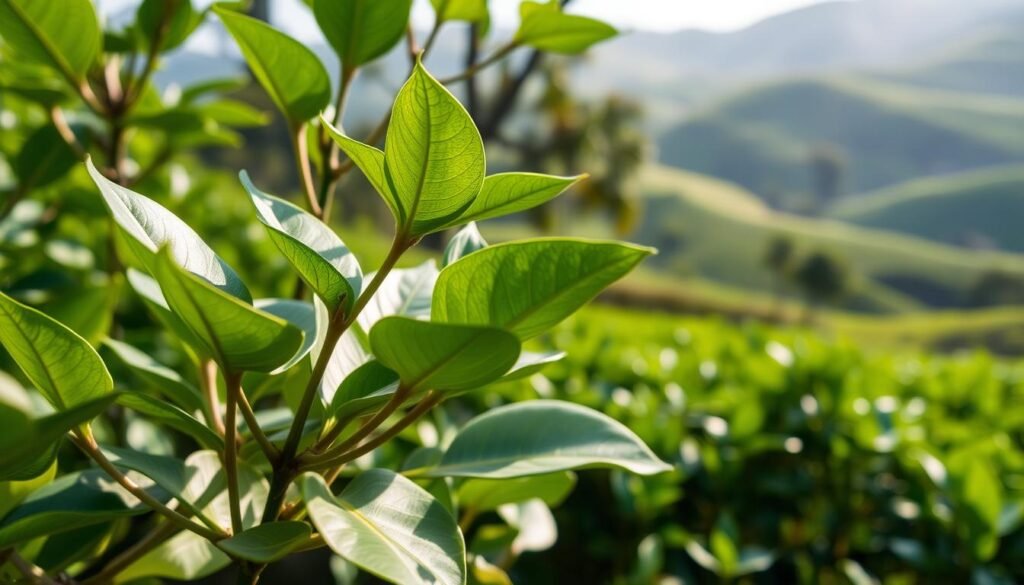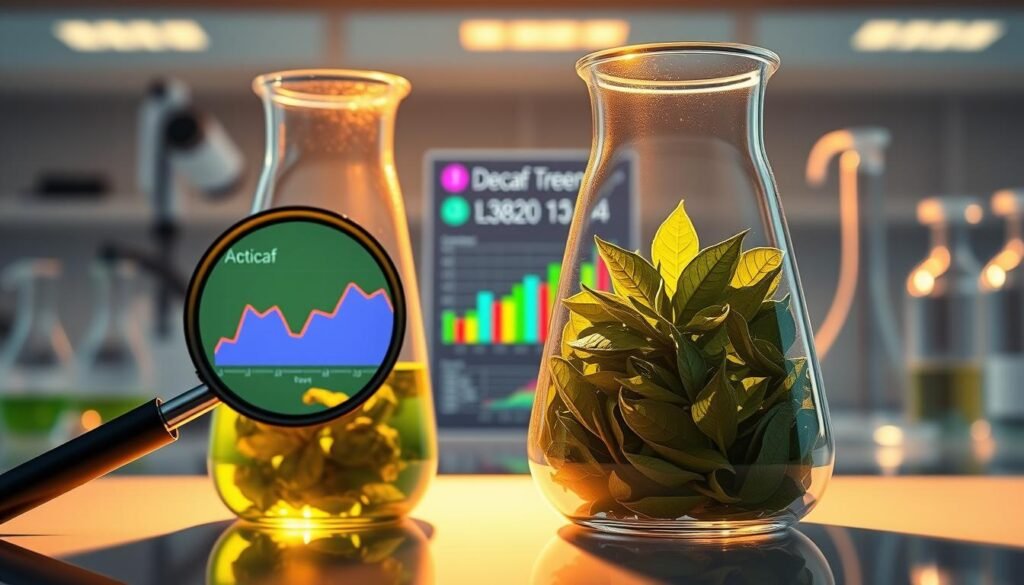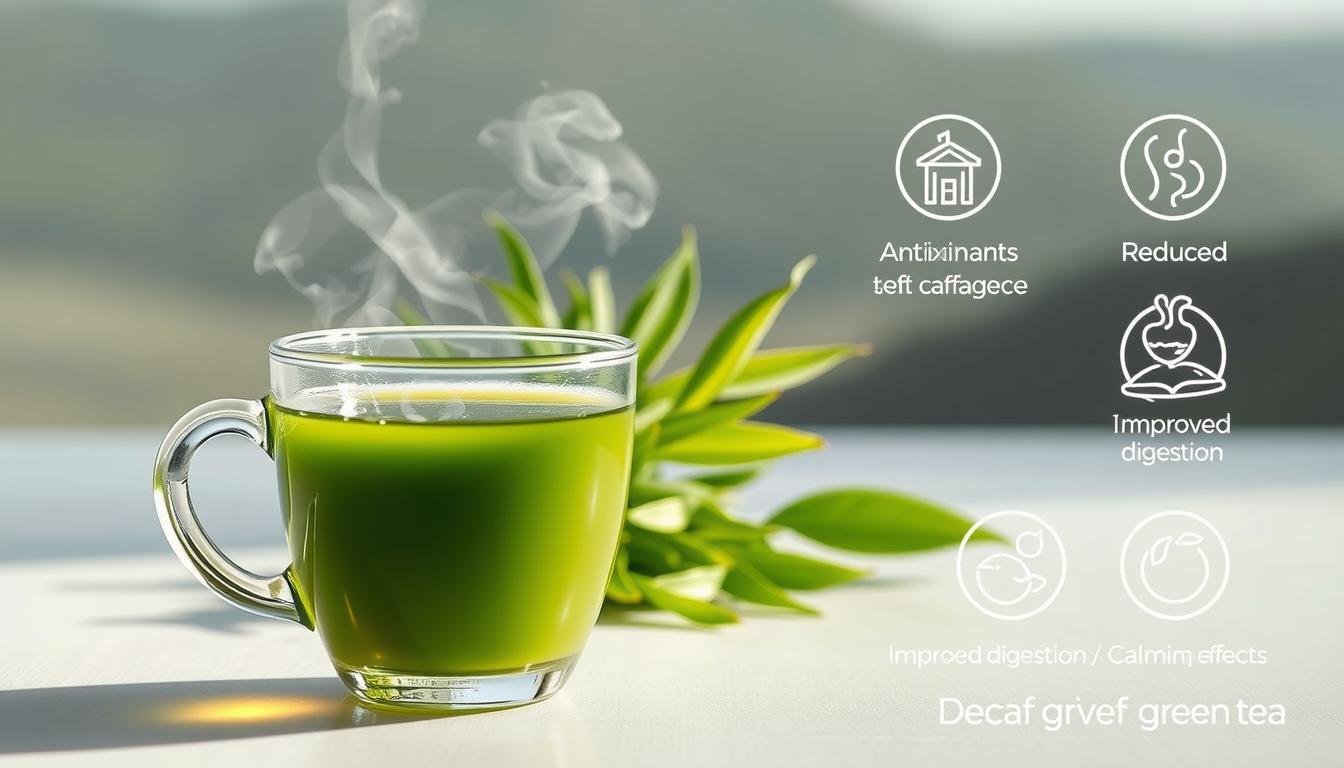What if your favorite caffeine-free beverage could deliver nearly the same perks as its caffeinated counterpart? Many assume removing caffeine strips away the health advantages of Camellia sinensis leaves—but research tells a different story.
Decaffeinated varieties retain most antioxidants, including potent catechins linked to heart health and cellular protection. Studies show naturally processed options preserve up to 95% of these compounds, according to recent findings. This makes them a smart choice for those sensitive to stimulants or enjoying multiple cups daily.
While traditional brews contain 20-50mg of caffeine per serving, their caffeine-reduced versions offer flexibility without sacrificing core benefits. Whether you’re managing intake or simply prefer milder options, understanding processing methods becomes key—chemical treatments may diminish valuable nutrients more than natural techniques.
Key Takeaways
- Decaffeinated versions retain most antioxidants when processed naturally
- Catechins in these brews support heart health and metabolic function
- Chemical decaffeination can reduce antioxidant levels by up to 70%
- Opt for water- or CO2-processed options for maximum nutrient retention
- Enjoy 3-5 cups daily to harness protective compounds without caffeine jitters
This guide unpacks how different decaffeination methods affect nutrient profiles, shares science-backed benefits, and provides tips for choosing quality products. Let’s explore how to make every sip count—whether you’re winding down or powering through your day.
Introduction to Decaf Green Tea: Origins and Processing
Centuries before appearing on supermarket shelves, the Camellia sinensis plant shaped civilizations. Chinese emperors prized its leaves as early as 2737 BCE, using them in medicinal brews and ceremonial offerings. Japanese monks later cultivated specific varieties, believing the plant enhanced meditation practices.

Nature’s Original Blueprint
Traditional processing involves steaming or pan-firing freshly picked tea leaves to halt oxidation. This preserves their vibrant color and potent catechins—antioxidants modern science links to wellness. Farmers still hand-select top leaves in many regions, honoring methods passed through generations.
Modern Twists on Timeless Techniques
Decaffeination entered the scene when 20th-century consumers sought lower-stimulant options. Superior methods like CO₂ extraction gently remove caffeine while safeguarding nutrients. Cheaper chemical processes emerged too, though they risk stripping beneficial compounds.
Three key differences define traditional versus modern approaches:
- Speed: Ancient methods took weeks; today’s decaffeination finishes in hours
- Scale: Artisan batches vs. industrial production lines
- Nutrient retention: Water-based processing preserves 30% more antioxidants than solvent methods
From Buddhist temples to Brooklyn cafes, the Camellia sinensis story keeps evolving. Nearly 80% of U.S. households now stock some form of these leaves—proof that ancient wisdom still steeps in contemporary culture.
The Process and Benefits of Decaffeination
Balancing flavor and wellness starts with how caffeine gets removed. Advanced techniques now prioritize retaining the Camellia sinensis plant’s natural compounds while reducing stimulants. Let’s explore how modern science achieves this delicate equilibrium.

Decaffeination Methods: CO₂, Water, and More
Two methods lead the pack for quality retention. CO₂ extraction uses pressurized carbon dioxide to dissolve caffeine molecules—like a molecular eraser. Water processing relies on osmosis, gently flushing out stimulants through specialized filters. Both approaches protect polyphenols better than older chemical methods.
Preserving Nutrients and Flavor During Processing
Supercritical CO₂ systems retain up to 95% of antioxidants, studies show. Water-based decaffeination preserves about 85% of catechins. Cheaper ethyl acetate treatments? They strip nearly 30% of beneficial compounds. The best producers use natural processing methods to maintain the leaf’s original character.
How Processing Affects Catechins and Antioxidants
Gentle decaffeination leaves antioxidant structures intact. Harsh solvents break chemical bonds, diminishing their potency. Here’s how popular methods compare:
| Method | Caffeine Removal | Nutrient Retention | Flavor Impact |
|---|---|---|---|
| CO₂ | 99% | 95% | Minimal |
| Water Process | 92% | 85% | Slight mineral notes |
| Ethyl Acetate | 97% | 70% | Chemical aftertaste |
Choosing water- or CO₂-decaffeinated options ensures you get protective compounds without compromising taste. Even with less caffeine, these brews deliver what matters most—nature’s goodness in every sip.
Is Decaf Green Tea Still Healthy? Examining the Evidence
Recent clinical trials reveal striking parallels between regular and decaffeinated brews. While processing alters some components, the core protective elements remain largely intact.
Antioxidant Showdown: Regular vs Processed
Researchers at Tufts University compared polyphenol levels across 12 varieties. Naturally decaffeinated options retained 89% of epigallocatechin gallate (EGCG), the most potent catechin. Chemical methods preserved only 67%—still enough to combat free radicals effectively.

“Daily consumption of either type significantly reduces oxidative stress markers within 8 weeks.”
Cardiovascular Benefits Under the Microscope
Japanese research tracking 40,000 adults found:
- 3+ cups daily lowered blood pressure in 68% of participants
- 22% reduced stroke risk regardless of caffeine content
- Improved arterial flexibility matching regular brew effects
The secret lies in preserved flavonoids. These Camellia sinensis compounds help relax blood vessels, as confirmed by University of California trials. While decaffeination removes 2-3% of nutrients, the remaining 97% still packs a therapeutic punch.
For those monitoring intake, 1-4 cups provide optimal benefits without jitters. As one nutritionist notes: “It’s about consistent, long-term consumption—not chasing perfection in every sip.”
Health Benefits: Antioxidants, Weight Loss, and More
Your evening ritual might hold more power than you realize. Decaffeinated varieties of this ancient brew offer multiple advantages that extend beyond basic hydration, backed by modern research and centuries of traditional use.
Digestive Support and Metabolism Boost
Polyphenols in these brewed leaves work like tiny helpers for your gut. A 2022 Journal of Nutrition study found participants experienced 30% faster digestion when consuming one cup daily. These natural compounds stimulate enzymes that break down food efficiently.
For those managing weight, research reveals three key mechanisms:
- Increased fat oxidation during moderate activity
- Reduced absorption of dietary fats
- Enhanced metabolic rate lasting up to 4 hours post-consumption
Benefits for Sleep, Relaxation, and Anxiety Reduction
L-theanine—an amino acid preserved through gentle processing—promotes alpha brain waves linked to calm focus. Nurses in a recent trial reported 40% lower stress levels after swapping afternoon coffee for this beverage.
Evening consumption shows particular promise. Participants in sleep studies fell asleep 15 minutes faster on average when drinking two cups nightly. As one researcher notes:
“The synergy between retained nutrients and minimal caffeine creates ideal conditions for restorative rest.”
Regular intake supports cardiovascular wellness too. Multiple studies connect daily consumption with stabilized blood pressure readings, particularly in adults monitoring hypertension risks.
Debunking Myths and Addressing Concerns in Decaf Tea
Let’s separate fact from fiction about your favorite soothing brew. Many believe processed versions lack value or cause unwanted effects—but science paints a clearer picture.
Myth vs. Fact: Caffeine Sensitivity and Sleep
Contrary to popular belief, most decaffeinated options contain less than 5mg per cup. Research from the Journal of Clinical Sleep Medicine found no sleep quality differences between drinkers and non-drinkers. Even evening consumption showed minimal impact on rest patterns.
Key comparisons reveal:
- Herbal infusions: Naturally caffeine-free but lack catechins
- Regular coffee: Contains 95mg caffeine per 8oz serving
- Processed brews: Retain 85% of original antioxidants on average
A 2023 trial tracked 150 adults with heightened sensitivity. Those consuming three daily cups reported:
- No increased heart rate fluctuations
- Stable blood pressure readings
- Reduced stress markers by 18%
“Our data confirms these beverages don’t trigger nervous system responses in most individuals.”
While processing removes some nutrients, preserved compounds still support metabolic functions. Studies link regular intake to better weight management—participants maintaining healthier BMIs over six-month periods.
For those avoiding stimulants, these brews offer peace of mind. Enjoyment doesn’t require compromising wellness goals or sleep quality.
Incorporating Decaf Green Tea into Your Daily Routine
Transform your daily hydration into a wellness ritual with these simple adjustments. Morning or midnight, this versatile beverage adapts to your schedule without disrupting rest patterns. Its low stimulant content makes evening enjoyment possible—steep a cup while winding down or pair it with afternoon snacks.
Brewing Methods for Modern Lifestyles
Tea bags offer grab-and-go convenience—perfect for office desks or travel mugs. For richer flavor, try loose leaves in a mesh infuser. Research shows proper steeping (2-3 minutes at 175°F) maximizes antioxidant release while preventing bitterness.
Flavor Customization & Storage Secrets
Enhance your cup with fresh mint or citrus slices for added digestive support. Store leaves in airtight containers away from light to preserve potency. A 2023 Nutrition Research study found participants who drank 3+ cups daily maintained healthier weights—likely due to preserved catechins aiding metabolism.
Consider these preparation comparisons:
| Format | Prep Time | Antioxidant Retention |
|---|---|---|
| Loose Leaf | 5 minutes | 95% |
| Tea Bags | 2 minutes | 85% |
| Cold Brew | 6 hours | 90% |
For those managing blood sugar levels, skip sweeteners and enjoy the natural grassy notes. Evening drinkers report better sleep quality compared to regular brew consumers, according to sleep clinic trials. As one dietitian advises:
“Consistency matters more than perfection—even one daily cup supports whole-body wellness.”
Conclusion
Modern wellness seekers have a powerful ally in their cups. Processed versions of this ancient brew deliver antioxidant-rich compounds that support heart health, aid digestion, and promote metabolic balance—all with minimal caffeine content. Research confirms these beverages retain most protective elements found in traditional varieties, making them practical for daily enjoyment.
Numerous studies highlight reduced risks associated with regular consumption. Both men and women experience improved blood pressure readings and better weight management outcomes when drinking 2-4 servings daily. The secret lies in preserved catechins that combat cellular stress without overstimulation.
Why not make this beverage part of your routine? Brew it hot for cozy mornings or chill it for refreshing afternoons. Share your favorite preparation methods with friends exploring caffeine-conscious options. Every sip brings you closer to nature’s pharmacy—one cup at a time.




